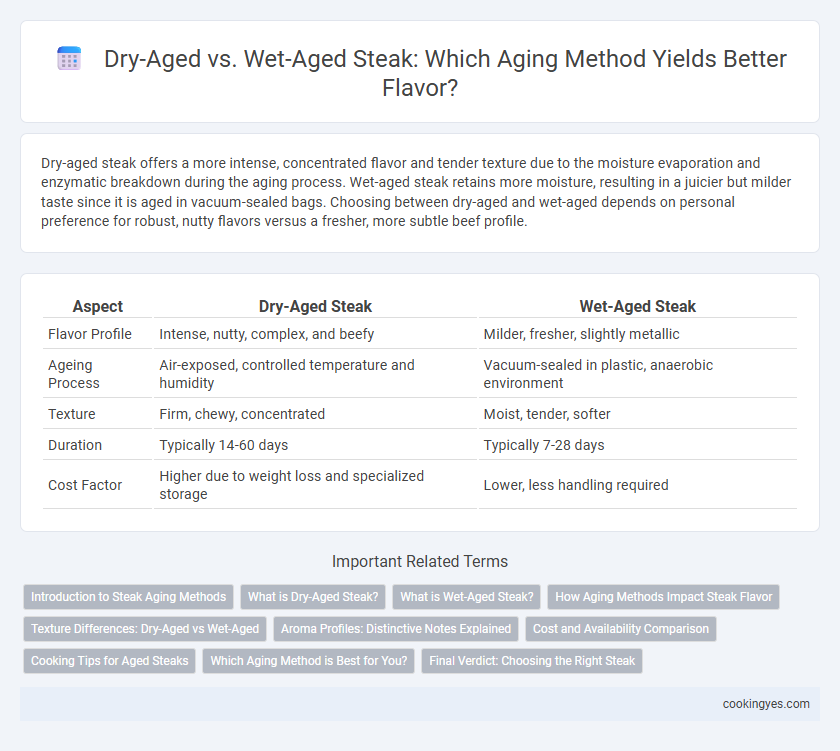Dry-aged steak offers a more intense, concentrated flavor and tender texture due to the moisture evaporation and enzymatic breakdown during the aging process. Wet-aged steak retains more moisture, resulting in a juicier but milder taste since it is aged in vacuum-sealed bags. Choosing between dry-aged and wet-aged depends on personal preference for robust, nutty flavors versus a fresher, more subtle beef profile.
Table of Comparison
| Aspect | Dry-Aged Steak | Wet-Aged Steak |
|---|---|---|
| Flavor Profile | Intense, nutty, complex, and beefy | Milder, fresher, slightly metallic |
| Ageing Process | Air-exposed, controlled temperature and humidity | Vacuum-sealed in plastic, anaerobic environment |
| Texture | Firm, chewy, concentrated | Moist, tender, softer |
| Duration | Typically 14-60 days | Typically 7-28 days |
| Cost Factor | Higher due to weight loss and specialized storage | Lower, less handling required |
Introduction to Steak Aging Methods
Dry-aged steak develops a deep, nutty flavor and tender texture through controlled air exposure that allows natural enzymes to break down muscle fibers. Wet-aged steak, sealed in vacuum packaging, retains juices and enhances tenderness while maintaining a fresher, more metallic taste. Both methods impact flavor profiles distinctly, with dry aging prized for complexity and wet aging favored for juiciness.
What is Dry-Aged Steak?
Dry-aged steak is beef that has been stored in a controlled, refrigerated environment with precise temperature and humidity for several weeks, allowing natural enzymes to break down muscle fibers and intensify flavor. This aging process develops a rich, nutty, and concentrated taste, along with a tender texture that distinguishes it from wet-aged steak. The dry-aging method also forms a crust on the meat's surface that is trimmed off before cooking, revealing deeply enhanced marbling and umami notes.
What is Wet-Aged Steak?
Wet-aged steak is beef that is vacuum-sealed in plastic and aged in its own juices for several days to weeks, enhancing tenderness and developing a subtly metallic, slightly tangy flavor. This method preserves moisture, resulting in a juicier texture compared to dry-aged steak, which undergoes controlled air exposure. Wet aging is commonly used in commercial settings due to its efficiency and cost-effectiveness while maintaining consistent, mild beef flavor.
How Aging Methods Impact Steak Flavor
Dry-aged steak develops a rich, concentrated flavor with nutty and earthy undertones due to moisture evaporation and enzymatic breakdown of muscle fibers. Wet-aged steak retains a more pronounced beefy and metallic taste because it ages in vacuum-sealed bags, preserving its natural juices but limiting flavor complexity. The choice between dry-aged and wet-aged methods significantly impacts the depth, tenderness, and aroma profile of the final steak.
Texture Differences: Dry-Aged vs Wet-Aged
Dry-aged steak features a firmer texture with a concentrated, nutty flavor due to moisture evaporation and enzymatic breakdown, enhancing tenderness and chew. Wet-aged steak retains more moisture, resulting in a juicier, softer texture with a milder, more metallic taste from vacuum-sealed aging. Texture differences between dry-aged and wet-aged steaks significantly influence the overall eating experience, favoring a denser bite in dry-aged and a more succulent mouthfeel in wet-aged.
Aroma Profiles: Distinctive Notes Explained
Dry-aged steaks develop complex aroma profiles characterized by nutty, earthy, and umami-rich notes due to enzymatic and microbial activity during prolonged aging in controlled humidity. Wet-aged steaks offer a more pronounced metallic and bloody scent with a fresher meat aroma, as the beef ages in vacuum-sealed packaging retaining its moisture. These distinctive smell characteristics influence the overall flavor experience, making dry-aging preferred for bold, intense flavors and wet-aging suitable for tender, milder taste preferences.
Cost and Availability Comparison
Dry-aged steaks typically cost 20-30% more than wet-aged due to the extended aging process and weight loss during drying, making them less widely available in regular supermarkets. Wet-aged beef is more common and cost-effective, as it involves vacuum-sealing the meat to retain moisture and accelerate tenderization with minimal weight reduction. Steakhouses and specialty butchers often allocate dry-aged cuts for premium menus, reflecting their limited supply and higher price point compared to the more accessible wet-aged steaks.
Cooking Tips for Aged Steaks
Dry-aged steaks develop a more intense, nutty flavor and tender texture due to moisture evaporation and enzymatic breakdown, while wet-aged steaks retain more juiciness with a milder taste from vacuum-sealed aging. For cooking dry-aged steaks, use high-heat methods like grilling or pan-searing to enhance the crust without overcooking the interior, and allow the steak to rest to redistribute juices. Wet-aged steaks benefit from moderate cooking temperatures and careful monitoring to preserve moisture and tenderness, making sous-vide or reverse searing ideal techniques.
Which Aging Method is Best for You?
Dry-aged steak offers a concentrated, nutty flavor with a firmer texture due to moisture evaporation and enzymatic breakdown, ideal for those seeking intense, robust taste. Wet-aged steak, sealed in vacuum packaging, retains more moisture, producing a tender, juicy profile favored for convenience and milder beef flavor. Choosing the best aging method depends on your preference for bold, complex flavors with dry-aged or softer, milder taste with wet-aged steaks.
Final Verdict: Choosing the Right Steak
Dry-aged steaks develop a concentrated, nutty flavor and tender texture due to moisture evaporation and enzymatic breakdown, making them ideal for flavor enthusiasts. Wet-aged steaks retain higher moisture content, offering a juicier, more consistent taste preferred for affordability and immediate consumption. Selecting the right steak depends on flavor intensity preference, budget considerations, and intended cooking method.
Dry-aged vs Wet-aged for Flavor Infographic

 cookingyes.com
cookingyes.com